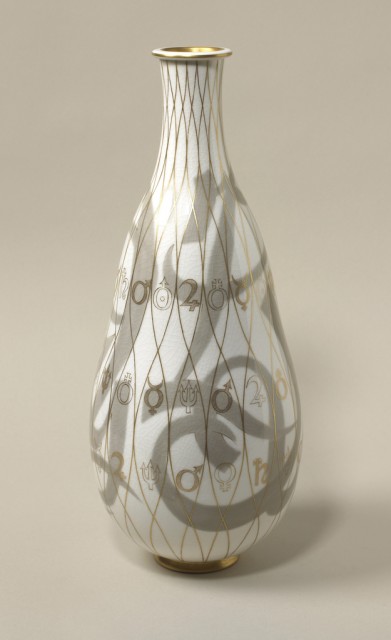Hendrick van Hulst, Head of the Department of Decoration at the Manufacture Nationale de Sèvres, once said, “the heavy and the trivial should be avoided; we should produce the light, sensitive, new and varied.” These words denote a clear desire, consistent with the firm's history, to set the Manufacture de Sèvres apart from all the European porcelain factories.
With its soft edges and smooth unity, this vase features a particularly interesting decoration and presents a combination of multiple ornamental elements that are whimsical yet elegant. Thick swirling ribbons in light grey color add a dynamic touch to the creamy off-white ground and their fanciful pattern, perhaps inspired by Arabic-like calligraphy, certainly plays with the vase’s curvy body. A hand-painted network of golden lines extending from the lip to the foot creates a grid while outlining various parts of the calligraphic motifs. In between the wavy lines of gold, are painted three horizontal rows of gilded Greek astronomical symbols encircling the body of the vase. In fact, the decade following the second World War, mostly characterized by the refusal of ornament in the decorative arts, still encouraged the creation of new imagery – the Cosmos was one of them. This imagery, promoting a vogue of astronomical motifs among many others, allowed for the development of a new era defined by a post-war consumer boom.
During the immediate post-war period, nearly all potters moved away from traditional utilitarian or decorative pottery towards a redefinition of the art of pottery and its practice. The Manufacture Nationale de Sèvres, however, positioned itself as the guardian of tradition, without adjusting its practices to follow the artistic and social developments of the time. Inaugurating itself as the institutional guardian of techniques and expertise, the Manufacture de Sèvres sought to emphasize the craft and mastery of its workers and the abundance of the Sèvres repertory of designs. Although forms and decorations tried to incorporate new, innovative and unique designs, they were often inspired by older styles and patterns. The vase entitled Jeux de Fonds – Astronomie, made at Sèvres, reinterprets traditional forms and common decorative schemes and combines them with new designs that focus on the purity associated with the popular ‘less is more’ maxim. By doing so, it positions itself in a particular moment in French history defined by a nationalistic approach to the decorative arts in order to establish the nation’s former prosperity.
After graduating from Sorbonne University, Paris with a degree in History of Art and Archeology, Melissa completed a graduate degree in Art Business at Sotheby's Institute of Art, London. She is currently enrolled in the History of Decorative Arts and Design program at Parsons, New York. Her professional experience includes internships at two major museums and one of the oldest auction houses in Istanbul as well as an internship at a well-established gallery in New York. She was also a Master's fellow in the Product Design and Decorative Arts Department at the Cooper-Hewitt, National Design Museum in New York.
